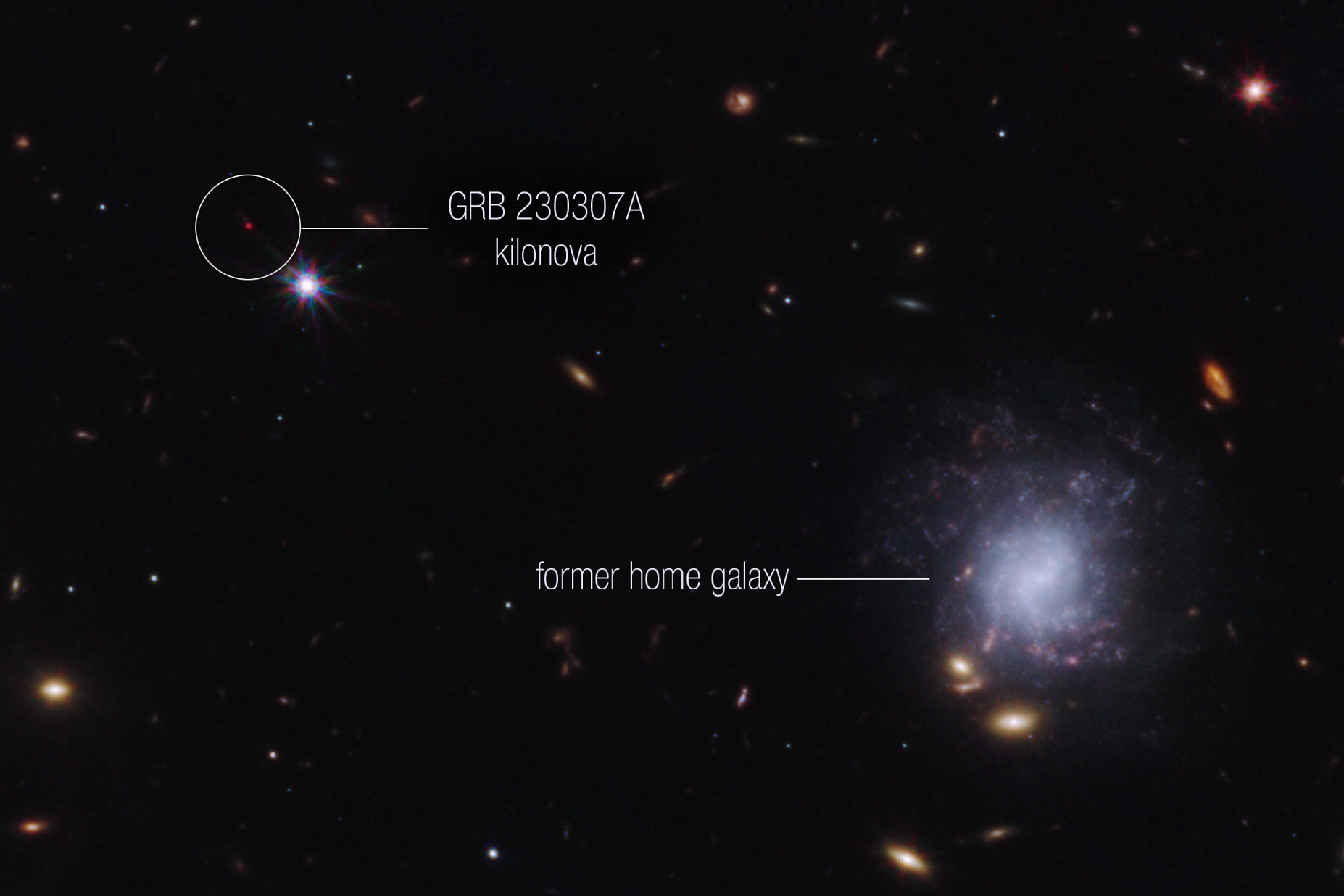Massive space explosion observed creating elements needed for life
The creation of rare chemical elements was seen in the second-brightest gamma-ray burst ever observed.

Astronomers have observed a massive space explosion – caused by the merging of two stars – creating the elements needed for life.
The creation of rare chemical elements was seen in the second-brightest gamma-ray burst (GRB) ever observed – casting new light on how heavy elements are made.
Researchers looked at GRB 230307A, which was caused by a neutron star merger in a spiral galaxy a billion light years away.
It is the first time the James Webb Space Telescope (JWST) has observed the merger of two stars, known as a kilonova.
This is an important next step in our understanding of the role binary neutron star mergers play in terms of populating the periodic table of elements
So energetic that it can throw out material, this process creates new atomic nuclei (the centres of atoms) – in a process known as nucleosynthesis.
The materials that form are some of the heaviest elements in nature, such as gold, platinum and uranium.
The new study, which included researchers at the University of Warwick and the University of Birmingham, observed evidence of tellurium, one of the rarest elements on Earth.
Other elements such as iodine and thorium, which are needed to sustain life on Earth, are also likely to be among the material ejected by the explosion.
Professor Danny Steeghs, from the Department of Physics at the University of Warwick, said: “This is an important next step in our understanding of the role binary neutron star mergers play in terms of populating the periodic table of elements.
“It complements the breakthrough achieved a few years ago thanks to gravitational wave detections, exploiting the step change that JWST now represents.”
The explosion was observed using an array of ground and space-based telescopes, including Nasa’s James Webb Space Telescope, Fermi Gamma-ray Space Telescope and Neil Gehrels Swift Observatory.
Kilonovae are extremely rare and very difficult to observe and study, which is why this discovery is so exciting
Dr Ben Gompertz, assistant professor of astronomy at the University of Birmingham, and co-author of the study, said: “Gamma-ray bursts come from powerful jets travelling at almost the speed of light – in this case driven by a collision between two neutron stars.
“These stars spent several billion years spiralling towards one another before colliding to produce the gamma-ray burst we observed in March this year.
“The merger site is the approximate length of the Milky Way (about 120,000 light-years) outside of their home galaxy, meaning they must have been launched out together.
“Colliding neutron stars provide the conditions needed to synthesise very heavy elements, and the radioactive glow of these new elements powered the kilonova we detected as the blast faded.
“Kilonovae are extremely rare and very difficult to observe and study, which is why this discovery is so exciting.”
GRBs are the most powerful and violent explosions in the known universe, and are short-lived bursts of gamma-ray light, the most energetic form of light.
Just over 150 years since Dmitri Mendeleev wrote down the periodic table of elements, we are now finally in the position to start filling in those last blanks of understanding where everything was made, thanks to the James Webb Telescope
GRB 230307A was one of the brightest ever observed – more than a million times brighter than the entire Milky Way galaxy combined.
Lead author of the study Andrew Levan, professor of astrophysics at Radboud University in the Netherlands, said: “Just over 150 years since Dmitri Mendeleev wrote down the periodic table of elements, we are now finally in the position to start filling in those last blanks of understanding where everything was made, thanks to the James Webb Telescope.”
GRB 230307A lasted for 200 seconds, meaning it is categorised as a long-duration gamma-ray burst.
This is unusual as short GRBs, which last less than two seconds, are more commonly caused by neutron star mergers.
The researchers are now seeking to learn more about how these neutron star mergers work and how they power these huge element-generating explosions.
The findings are published in the Nature journal.
Subscribe to Independent Premium to bookmark this article
Want to bookmark your favourite articles and stories to read or reference later? Start your Independent Premium subscription today.
